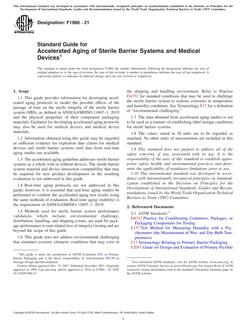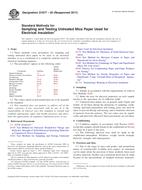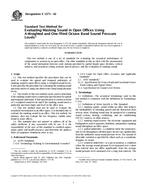1.1 This method affords an estimate of the relative radiant power (that is, the Stray Radiant Power Ratio (SRPR) at wavelengths remote from those of the nominal pass band transmitted through the monochromator of an absorption spectrophotometer. Test-filter materials are described that discriminate between the desired wavelengths and those which contribute most to SRP for conventional commercial spectrophotometers used in the ultraviolet, the visible, the near infrared, and the alkali halide infrared ranges. These procedures apply to instruments of conventional design, with usual sources, detectors, and optical designs. The vacuum ultraviolet and the far infrared present special problems that are not discussed herein.
Note 1-An equivalent test method (1,2) for use in the ultraviolet that is easier and faster to perform might be preferred, especially when frequent testing is indicated. Note 2-Recent research (3) has shown that particular care must be exercised in testing grating spectrophotometers that use moderately narrow bandpass blocking filters. See 4.2.
1.2 These procedures are neither all-inclusive nor infallible. Because of the nature of readily available filter materials, with a few exceptions the procedures are insensitive to SRP of shorter wavelengths in the ultraviolet or visible, or of lower frequencies in the infrared, and they are not necessarily valid for “spike” SRP nor for “nearby SRP.” (See Annexes for general discussion and definitions of these terms.) However, they are adequate in most cases and for typical applications. They do cover instruments using prisms or gratings, in either single or double monochromators.
1.3 The proportion of SRP (that is, SRPR) encountered with a well-designed monochromator, used in a favorable spectral region, is a small fraction of 1%. With a double monochromator it may easily be less than 1 ppm even with a broad-band continuum source. Under these conditions, it may be difficult to do more than determine that it falls below a certain level. Actual measurement often requires special techniques and instrument operating conditions that are not typical of those occurring during use. When absorption measurements with continuum sources are being made, it is frequently true that, owing to the effect of slit width on SRP in a double monochromator, these test procedures tend to give “conservative” results; that is, because larger slit widths than normal must be used to admit enough energy to the monochromator to permit evaluation of the SRP, the stray proportion indicated is greater than would normally be encountered in use.
1.4 The principal reason for a test procedure that is not exactly representative of normal operation is that the effects of SRP are “magnified” in sample measurements at high absorbance. It is usually necessary to increase sensitivity in some way during the test in order to evaluate the SRP adequately. This is usually accomplished by increasing slit width and so obtaining sufficient energy to allow meaningful measurement of the SRP after the monochromatic energy has been removed by the SRP (test) filter. A further reason for increasing energy or sensitivity can be that many instruments have only absorbance scales, which obviously do not extend to zero transmittance. Even a SRP proportion as large as 1% may fall outside the measurement range.
1.5 Many instruments that use optical attenuators to balance sample absorption make relatively inaccurate measurements below 10% transmittance, because of poor attenuator linearity. All instruments should be carefully and frequently checked if used below about 1% transmittance because of the possibility of zero shift due to electrical pickup or other causes. For these reasons, the test procedure specifies that the measurements be made within 100% and 10% on the scale. Obviously this is not required if reliable photometric linearity and zero checks are made under the conditions prevailing during the test, and use of the 10 and 1% range may give lower and more accurately representative SRP values. In marginal cases this more elaborate test procedure, incorporating accepted ASTM tests for photometric linearity, may be justified.
1.6 High accuracy in SRP measurement is not required. A measurement reliable within 10 or 20% is always sufficient, but often many readings must be cascaded to obtain the final result, so that painstaking measurements are desirable.
1.7 This standard may involve hazardous materials, operations, and equipment. This standard does not purport to address all of the safety problems associated with its use. It is the responsibility of whoever uses this standard to consult and establish appropriate safety and health practices and determine the applicability of regulatory limitations prior to use.
Product Details
- Published:
- 01/01/1995
- Number of Pages:
- 12
- File Size:
- 1 file , 120 KB


